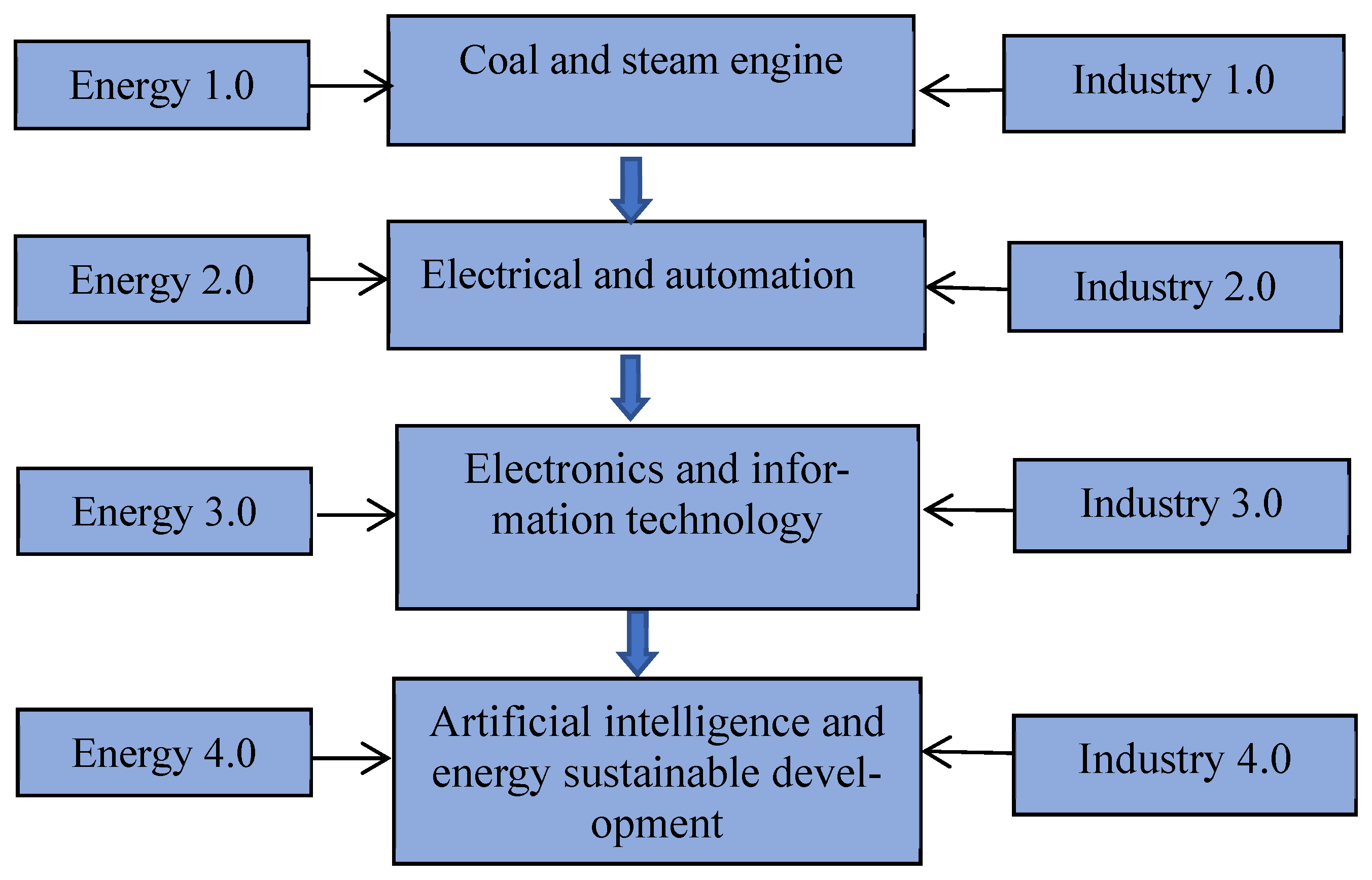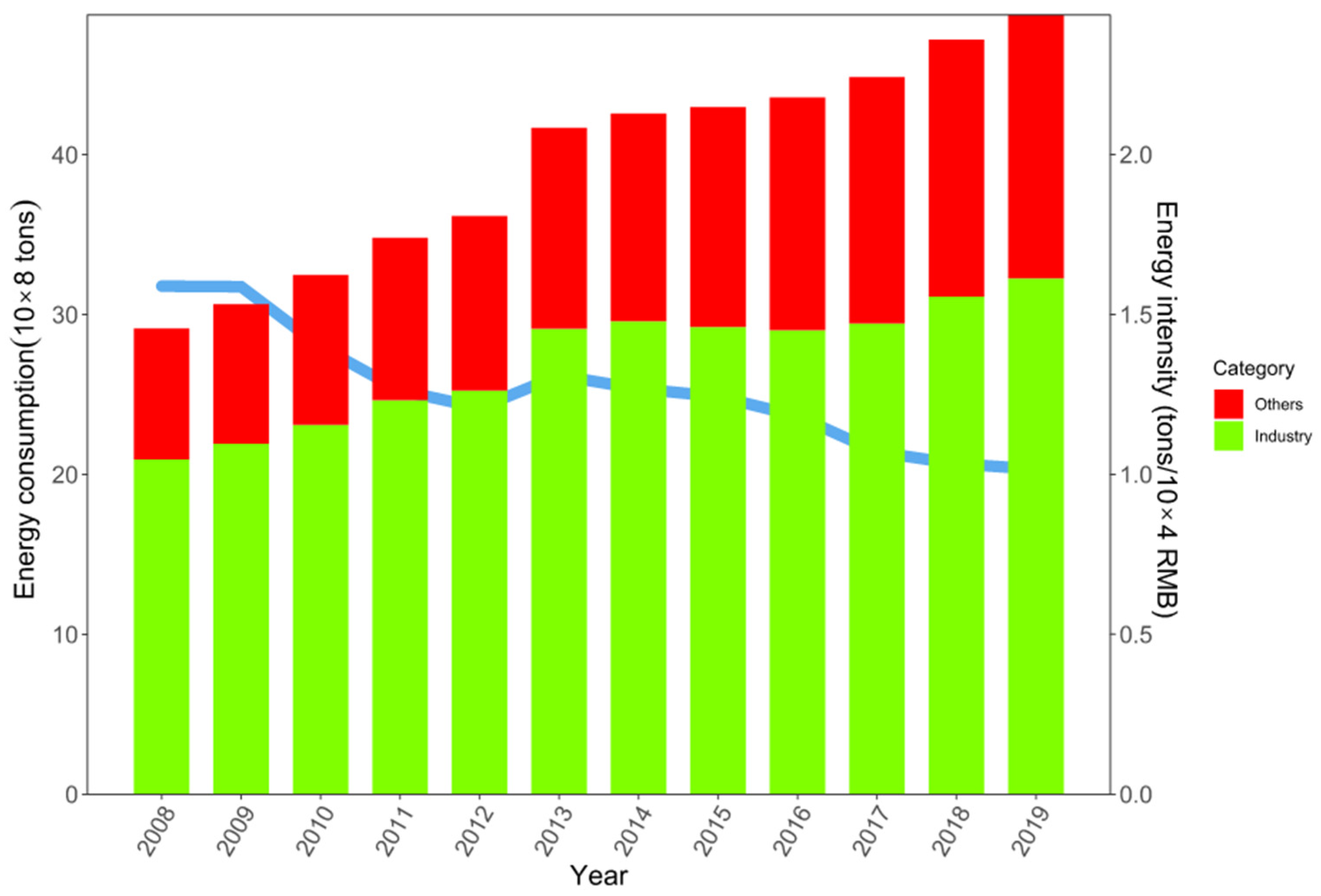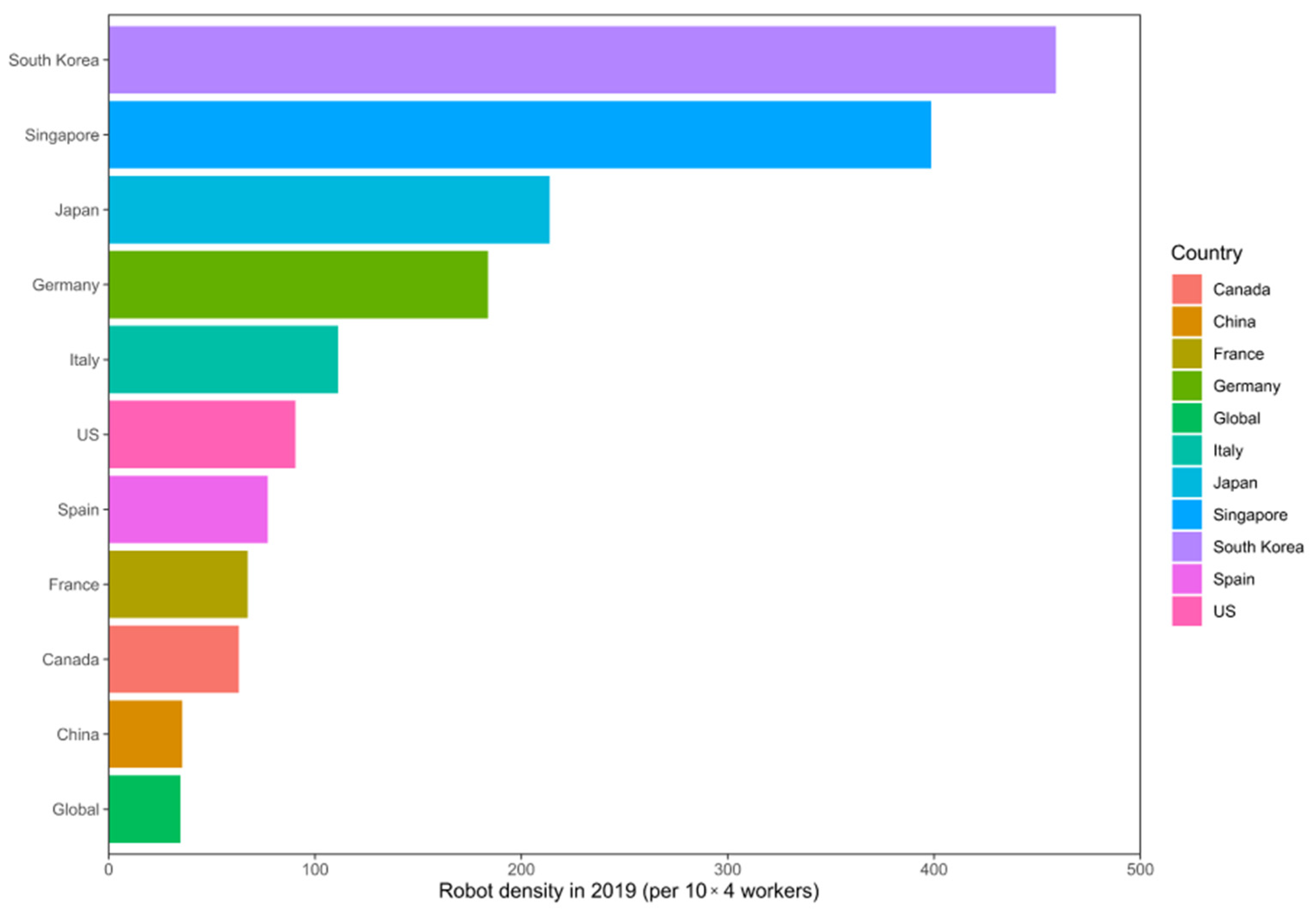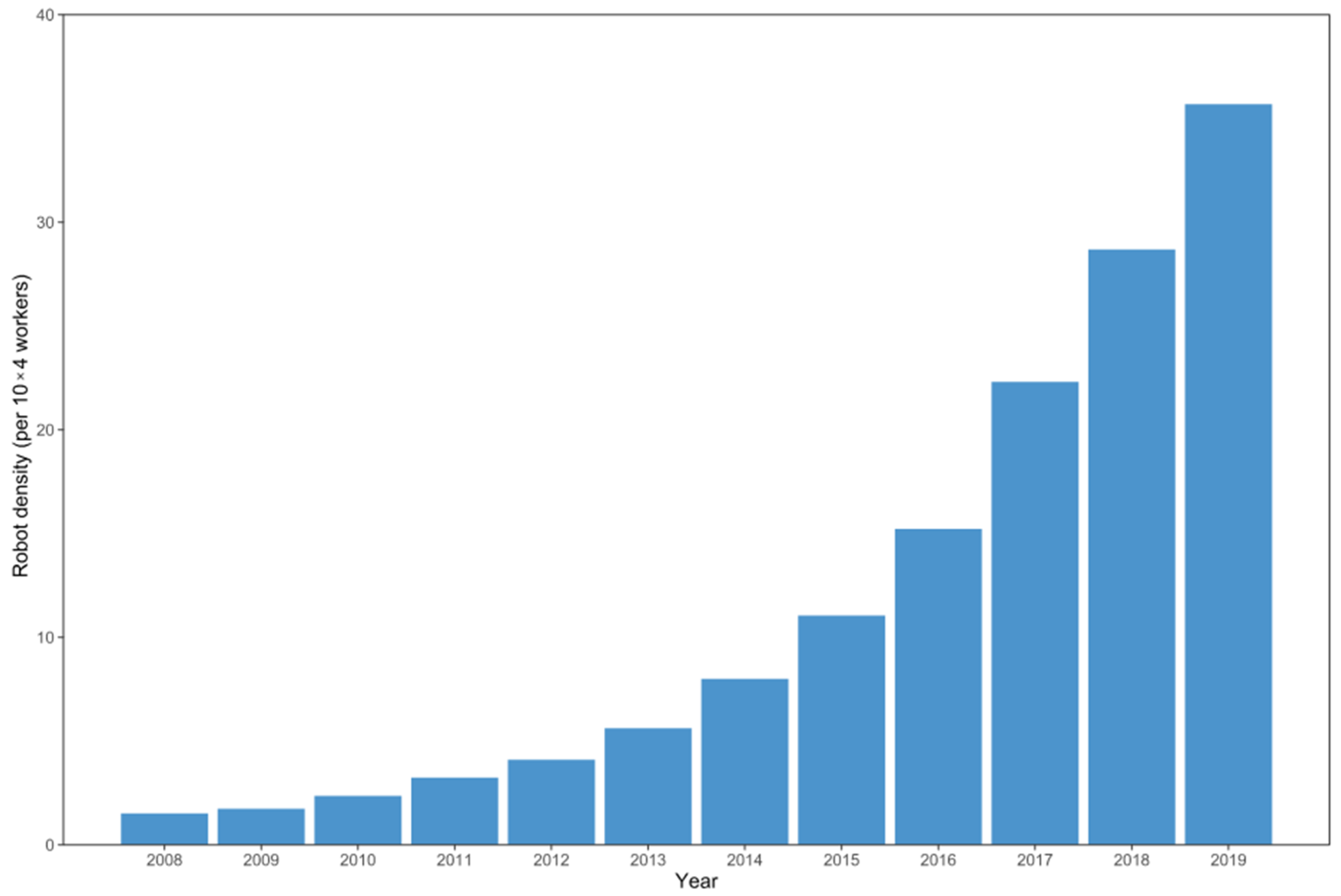The Impact of Industrial Intelligence on Energy Intensity: Evidence from China
Abstract
:1. Introduction
2. Theoretical Background
2.1. R&D Activity
2.2. Enterprise Scale
2.3. Capital Intensity
2.4. Enterprise Ownership Structure
3. Methodology
3.1. Model and Variables
3.2. Data Sources
4. Empirical Results
4.1. Industrial Energy Intensity and Industrial Robot Adoption
4.2. Endogenous Test
4.3. Robust Stability Test
5. Conclusions
Author Contributions
Funding
Institutional Review Board Statement
Informed Consent Statement
Data Availability Statement
Conflicts of Interest
References
- Eskeland, G.S.; Harrison, A.E. Moving to greener pastures? Multinationals and the pollution haven hypothesis. J. Dev. Econ. 2003, 70, 1–23. [Google Scholar] [CrossRef] [Green Version]
- Ghobakhloo, M. Industry 4.0, digitization, and opportunities for sustainability. J. Clean. Prod. 2019, 252, 119869. [Google Scholar] [CrossRef]
- Szlávik, J.; Szép, T. A Framework of Risks in the Context of Industry 4.0, Related to Sustainability. World Futur. 2022, 1–24. [Google Scholar] [CrossRef]
- Dekle, R. Robots and industrial labor: Evidence from Japan. J. Jpn. Int. Econ. 2020, 58, 101108. [Google Scholar] [CrossRef]
- Lin, B.; Wu, W.; Song, M. Industry 4.0: Driving factors and impacts on firm’s performance: An empirical study on China’s manufacturing industry. Ann. Oper. Res. 2019, 1–21. [Google Scholar] [CrossRef]
- Di Vaio, A.; Palladino, R.; Hassan, R.; Escobar, O. Artificial intelligence and business models in the sustainable development goals perspective: A systematic literature review. J. Bus. Res. 2020, 121, 283–314. [Google Scholar] [CrossRef]
- Hannan, M.; Al-Shetwi, A.Q.; Ker, P.J.; Begum, R.; Mansor, M.; Rahman, S.; Dong, Z.; Tiong, S.; Mahlia, T.I.; Muttaqi, K. Impact of renewable energy utilization and artificial intelligence in achieving sustainable development goals. Energy Rep. 2021, 7, 5359–5373. [Google Scholar] [CrossRef]
- Cette, G.; Devillard, A.; Spiezia, V. The contribution of robots to productivity growth in 30 OECD countries over 1975–2019. Econ. Lett. 2021, 200, 109762. [Google Scholar] [CrossRef]
- Guerry, M.; Bieller, S.; Mueller, C.; Kraus, W. IFR Press Conference 24th September 2020 Frankfurt. International Federation of Robotics, IFR. Available online: https://ifr.org/ifr-press-releases/news/record-2.7-million-robots-work-in-factories-around-the-globe (accessed on 5 October 2021).
- Pinzón, K. Dynamics between energy consumption and economic growth in Ecuador: A granger causality analysis. Econ. Anal. Policy 2018, 57, 88–101. [Google Scholar] [CrossRef] [Green Version]
- Chen, X.; Gong, X.; Li, D.; Zhang, J. Can information and communication technology reduce CO2 emission? A quantile regression analysis. Environ. Sci. Pollut. Res. 2019, 26, 32977–32992. [Google Scholar] [CrossRef]
- Dong, K.; Sun, R.; Hochman, G.; Li, H. Energy intensity and energy conservation potential in China: A regional comparison perspective. Energy 2018, 155, 782–795. [Google Scholar] [CrossRef]
- Voigt, S.; DE Cian, E.; Schymura, M.; Verdolini, E. Energy intensity developments in 40 major economies: Structural change or technology improvement? Energy Econ. 2014, 41, 47–62. [Google Scholar] [CrossRef] [Green Version]
- Tan, R.; Lin, B. What factors lead to the decline of energy intensity in China’s energy intensive industries? Energy Econ. 2018, 71, 213–221. [Google Scholar] [CrossRef]
- Zhu, J.; Niu, L.; Ruth, M.; Shi, L. Technological Change and Energy Efficiency in Large Chinese Firms. Ecol. Econ. 2018, 150, 241–250. [Google Scholar] [CrossRef]
- Luan, B.; Huang, J.; Zou, H.; Huang, C. Determining the factors driving China’s industrial energy intensity: Evidence from technological innovation sources and structural change. Sci. Total Environ. 2020, 737, 139767. [Google Scholar] [CrossRef]
- Macharia, K.K.; Gathiaka, J.K.; Ngui, D. Energy efficiency in the Kenyan manufacturing sector. Energy Policy 2021, 161, 112715. [Google Scholar] [CrossRef]
- Sharma, R.; Shahbaz, M.; Kautish, P.; Vo, X.V. Analyzing the impact of export diversification and technological innovation on renewable energy consumption: Evidences from BRICS nations. Renew. Energy 2021, 178, 1034–1045. [Google Scholar] [CrossRef]
- Earnhart, D.; Lizal, L. Effects of ownership and financial performance on corporate environmental performance. J. Comp. Econ. 2006, 34, 111–129. [Google Scholar] [CrossRef]
- Liu, L.; Yang, K.; Fujii, H.; Liu, J. Artificial intelligence and energy intensity in China’s industrial sector: Effect and transmission channel. Econ. Anal. Policy 2021, 70, 276–293. [Google Scholar] [CrossRef]
- Zhao, X.; Hu, S. Does market-based electricity price affect China’s energy efficiency? Energy Econ. 2020, 91, 104909. [Google Scholar]
- Bu, M.; Li, S.; Jiang, L. Foreign direct investment and energy intensity in China: Firm-level evidence. Energy Econ. 2019, 80, 366–376. [Google Scholar] [CrossRef]
- Zheng, Y.; Qi, J.; Chen, X. The effect of increasing exports on industrial energy intensity in China. Energy Policy 2011, 39, 2688–2698. [Google Scholar] [CrossRef]
- Fisher-Vanden, K.; Jefferson, G.H.; Liu, H.; Tao, Q. What is driving China’s decline in energy intensity? Resour. Energy Econ. 2004, 26, 77–97. [Google Scholar] [CrossRef]
- Shen, X.; Lin, B. Does industrial structure distortion impact the energy intensity in China? Sustain. Prod. Consum. 2020, 25, 551–562. [Google Scholar] [CrossRef]
- Ballestar, M.T.; Díaz-Chao, Á.; Sainz, J.; Torrent-Sellens, J. Knowledge, robots and productivity in SMEs: Explaining the second digital wave. J. Bus. Res. 2019, 108, 119–131. [Google Scholar] [CrossRef]
- Jung, J.H.; Lim, D.-G. Industrial robots, employment growth, and labor cost: A simultaneous equation analysis. Technol. Forecast. Soc. Change 2020, 159, 120202. [Google Scholar] [CrossRef]
- Liu, J.; Chang, H.; Forrest, J.Y.-L.; Yang, B. Influence of artificial intelligence on technological innovation: Evidence from the panel data of china’s manufacturing sectors. Technol. Forecast. Soc. Change 2020, 158, 120142. [Google Scholar] [CrossRef]
- Cheng, M.; Yang, S.; Wen, Z. The effect of technological factors on industrial energy intensity in China: New evidence from the technological diversification. Sustain. Prod. Consum. 2021, 28, 775–785. [Google Scholar] [CrossRef]
- Li, M.; Gao, Y.; Liu, S. China’s energy intensity change in 1997–2015: Non-vertical adjusted structural decomposition analysis based on input-output tables. Struct. Change Econ. Dyn. 2020, 53, 222–236. [Google Scholar] [CrossRef]
- Fisher-Vanden, K.; Hu, Y.; Jefferson, G.; Rock, M.; Toman, M. Factors influencing energy intensity in four Chinese industries. Energy J. 2016, 37, 153–178. [Google Scholar] [CrossRef]
- Schleich, J. Barriers to energy efficiency: A comparison across the German commercial and services sector. Ecol. Econ. 2009, 68, 2150–2159. [Google Scholar] [CrossRef]
- Lin, B.; Chen, Y.; Zhang, G. Impact of technological progress on China’s textile industry and future energy saving potential forecast. Energy 2018, 161, 859–869. [Google Scholar] [CrossRef]
- Lan, J.; Kakinaka, M.; Huang, X. Foreign Direct Investment, Human Capital and Environmental Pollution in China. Environ. Resour. Econ. 2011, 51, 255–275. [Google Scholar] [CrossRef]
- Fu, T. How does government intervention determine a Firm’s fuel intensity: Evidence from China. J. Clean. Prod. 2018, 196, 1522–1531. [Google Scholar] [CrossRef]
- Graetz, G.; Michaels, G. Robots at work. Rev. Econ. Stat. 2018, 100, 753–768. [Google Scholar] [CrossRef] [Green Version]
- Lan, J.; Malik, A.; Lenzen, M.; McBain, D.; Kanemoto, K. A structural decomposition analysis of global energy footprints. Appl. Energy 2016, 163, 436–451. [Google Scholar] [CrossRef]
- Rahnama, M.R.; Abkooh, S.S. The effect of air pollutant and built environment criteria on unhealthy days in Mashhad, Iran: Using OLS regression. Urban Clim. 2021, 37, 100836. [Google Scholar] [CrossRef]
- Carvalho, C.; Nechio, F.; Tristão, T. Taylor rule estimation by OLS. J. Monetary Econ. 2021, 124, 140–154. [Google Scholar] [CrossRef]
- Xie, Z.; Wu, R.; Wang, S. How technological progress affects the carbon emission efficiency? Evidence from national panel quantile regression. J. Clean. Prod. 2021, 307, 127133. [Google Scholar] [CrossRef]
- Gultekin, H.; Gürel, S.; Taspinar, R. Bicriteria scheduling of a material handling robot in an m-machine cell to minimize the energy consumption of the robot and the cycle time. Robot. Comput. Manuf. 2021, 72, 102207. [Google Scholar] [CrossRef]
- Jin, M.; Tang, R.; Ji, Y.; Liu, F.; Gao, L.; Huisingh, D. Impact of advanced manufacturing on sustainability: An overview of the special volume on advanced manufacturing for sustainability and low fossil carbon emissions. J. Clean. Prod. 2017, 161, 69–74. [Google Scholar] [CrossRef]






| Variable | Definition | Variable | Definition |
|---|---|---|---|
| Std.Dev. | Standard Deviation | Max | Maximum Value |
| Obs. | Observes | Min | Minimum Value |
| Mean | Mean Value of Variables | _con | Constant |
| OLS | Ordinary Least Squares | R2 | Goodness of Fit, Coefficient of Determination |
| WLS | Weighted Least Square | F | F-test OR Joint Significant Test |
| 2SLS. | Two Stage Least Square | Prob | Probability Value |
| Variable | Definition | Obs. | Mean | Std. Dev. | Min | Max |
|---|---|---|---|---|---|---|
| robots | Industrial robot stock in China | 11 | 281,979 | 258,786 | 31,787 | 782,725 |
| EI | Industrial energy intensity | 11 | 1.252 | 0.193 | 1.017 | 1.589 |
| EIL | Industrial electric intensity | 11 | 0.175 | 0.011 | 0.160 | 0.194 |
| AI | Artificial intelligence rate | 11 | 32.191 | 32.106 | 3.597 | 98.716 |
| IV | Robot stocks in Japan | 11 | 313,627 | 24,494 | 286,554 | 355,562 |
| Scale | Income of major industrial firms | 11 | 2.554 | 0.678 | 1.173 | 3.061 |
| R&D | Number of patent applications | 11 | 608,630 | 274,597 | 173,573 | 1,059,808 |
| Capital | Firm assets per employees | 11 | 98.017 | 32.817 | 48.803 | 152.082 |
| Ownership | Rate of assets of state-owned firms | 11 | 0.486 | 0.009 | 0.474 | 0.501 |
| EI | OLS | WLS |
|---|---|---|
| Robots | −0.002553 ** | −0.0082617 ** |
| (0.022) | (0.019) | |
| Scale | −0.3339558 *** | −0. 3405349 *** |
| (0.000) | (0.000) | |
| R&D | −0.0062920 * | −0.0064196 ** |
| (0.095) | (0.049) | |
| Capital | 0.0122092 ** | 0.0112854 ** |
| (0.038) | (0.032) | |
| Ownership | −5.90036 * | −7.527523 ** |
| (0.076) | (0.013) | |
| (0.024) | (0.004) |
| EI | First Stage | Second Stage |
|---|---|---|
| Robots | −0.0040651 *** | |
| (0.000) | ||
| IV | 1.17338 ** | |
| (0.028) | ||
| Scale | −70,943.67 ** | −0.4100642 *** |
| (0.037) | (0.000) | |
| R&D | −0. 0617938 ** | −0.0055533 ** |
| (0.805) | (0.036) | |
| Capital | 9,868.284 *** | 0.0176571 *** |
| (0.004) | (0.001) | |
| Ownership | 3,360,842 ** | −3.810791 * |
| (0.026) | (0.052) |
| (1) | (2) | |||
|---|---|---|---|---|
| OLS | WLS | OLS | WLS | |
| AI Robots | −0.0009575 *** | −0.0009575 *** | −0.006432 *** | −0.0064629 *** |
| (0.009) | (0.009) | (0.002) | (0.002) | |
| Scale | −0.0225685 *** | −0.0225684 *** | −0.3268144 *** | −0.3252669 *** |
| (0.001) | (0.001) | (0.000) | (0.000) | |
| R&D | −0.0024958 ** | −0.0024958 ** | −0.0045503 | 0.0047235 * |
| (0.048) | (0.048) | (0.101) | (0.094) | |
| Capital | 0.0014173 ** | 0.0014176 ** | 0.008501 ** | 0.0086925 ** |
| (0.021) | (0.021) | (0.032) | (0.032) | |
| Ownership | −0.1606798 * | −0.1604305 | −6.500448 ** | −6.378903 ** |
| (0.236) | (0.239) | (0.012) | (0.012) | |
Publisher’s Note: MDPI stays neutral with regard to jurisdictional claims in published maps and institutional affiliations. |
© 2022 by the authors. Licensee MDPI, Basel, Switzerland. This article is an open access article distributed under the terms and conditions of the Creative Commons Attribution (CC BY) license (https://creativecommons.org/licenses/by/4.0/).
Share and Cite
Zhang, X.; Liu, P.; Zhu, H. The Impact of Industrial Intelligence on Energy Intensity: Evidence from China. Sustainability 2022, 14, 7219. https://doi.org/10.3390/su14127219
Zhang X, Liu P, Zhu H. The Impact of Industrial Intelligence on Energy Intensity: Evidence from China. Sustainability. 2022; 14(12):7219. https://doi.org/10.3390/su14127219
Chicago/Turabian StyleZhang, Xiekui, Peiyao Liu, and Hongfei Zhu. 2022. "The Impact of Industrial Intelligence on Energy Intensity: Evidence from China" Sustainability 14, no. 12: 7219. https://doi.org/10.3390/su14127219
APA StyleZhang, X., Liu, P., & Zhu, H. (2022). The Impact of Industrial Intelligence on Energy Intensity: Evidence from China. Sustainability, 14(12), 7219. https://doi.org/10.3390/su14127219






